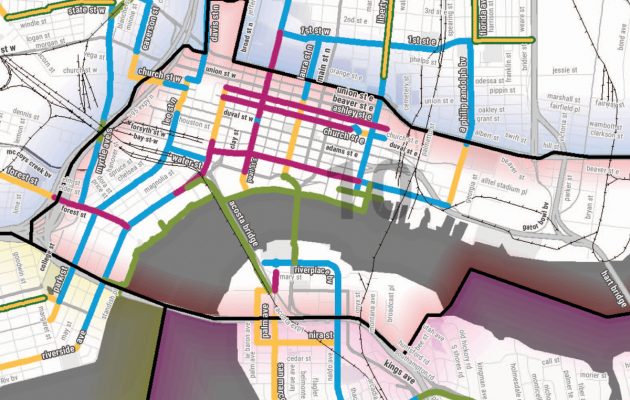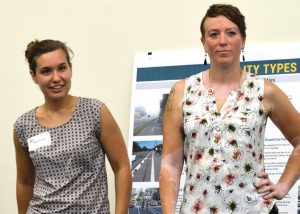Consultants update community on city bike-ped master study
Posted on September 3, 2016 By Editor Articles, Neighborhood News, Top Stories

Halfway during its 18-month Bicycle and Pedestrian Master Plan Study, consultants hired by the City of Jacksonville were still seeking community input in order to find ways to transform Jacksonville into one of the best cities for walking and biking in the Southeast.
In the first of two public meetings held Aug. 23 and Aug. 25, more than 30 residents, pedestrian advocates and bike aficionados gathered at the Jewish Community Alliance to hear Andrew Clarke, director of strategy for Toole Design Group and the former president of the League of American Bicyclists, give an update on the study. A second similar meeting was held on the Westside at St. Andrews Presbyterian Church at 6317 103rd Street.

Jacksonville City Planner Stephanie Zarkis and City Bicycle-Pedestrian Coordinator Amy Ingles attended a Pedestrian/Bicycle Master Plan Study Aug. 23 at the Jewish Community Alliance.
On hand at the meeting were Amy Ingles, the city’s new bicycle/pedestrian coordinator, Stephanie Zarkis, city planner, Heather Deutsch of Toole Design Group, Victoria Pennington of MVP Marketing and Public Affairs, Cantrece Jones of Acuity Design Group, and Chris Burns of San Marco, who serves as head of the city’s Bike-Pedestrian Committee and is on the master plan study steering committee.
Although she could not attend the meeting, Clarke said Jacksonville City Council President Lori Boyer is “very committed” to the study, and, like many of the residents she represents, wants to make sure “something actually happens from this exercise” and that it “does not just turn into a round of discussions.”
Recognizing most of the American cities which are thriving and successful economically have made a special effort to make roads more bike-able and enhance their walkability, the City of Jacksonville commissioned the study to provide a framework – a strategic plan – to set up a priority list of short- and long-term projects to improve Jacksonville’s infrastructure and recommend a connective network of roads on which to make improvements.
In order to get the “lay of the land,” the consultants have been studying several “existing conditions,” including the number and location of motor vehicle, bicycle and pedestrian crashes, usage of the roads, infrastructure, culture, as well as previous studies from other agencies and the desires of stakeholders within the Jacksonville walking and biking communities, Clarke said.
The study includes only Mobility Zones 7, 8, 9, and 10, which encompasses the urban core and many neighborhoods within the I-295 beltway. San Marco, St. Nicholas, San Jose as well as Riverside, Avondale, Ortega and Murray Hill are included in the study.
“The not so surprising conclusion we’ve come to is that this is a big city – the largest in the 48 states – covering a big area and just in the core we are facing big challenges,” Clarke said, noting Jacksonville benefits from being flat and has an active population that is out biking and walking at all hours of the day and night.
Although crash maps show an exorbitant number of pedestrian and bicycle crashes in Jacksonville each year, motor vehicle crash maps are equally alarming, he said. “The whole city is one giant blob,” he said, noting in one year there were between 15,000 and 18,000 motor vehicle crashes with injuries. “The problems we have with bicycling and walking safety are not unique to bicycling and walking safety,” he said. “It’s more about our driving habits than just our walking and biking habits.”
Walking and bike strategies
In considering the problems facing Jacksonville’s pedestrians, Clarke said the consultants had categorized the city’s roadways into five types of streets, but highlighted two kinds, downtown streets and residential streets. Downtown streets are good for pedestrians because they include sidewalks on both sides of the roads, traffic signals and crosswalks. Residential streets usually are without sidewalks or crosswalks and do not meet Americans with Disabilities Act (ADA) standards.
The study looked to identify five to 15 streets based on crash locations and research where different pedestrian facilities such as ADA-compliant sidewalks, high visibility crosswalks and curb ramps, raised crosswalks, median islands, curb extensions, rectangular rapid flashing beacons, raised intersections and automatic pedestrian signals might make a difference.
One way to solve the problems connected with pedestrian mobility might be to “prioritize neighborhoods like they do in storm water maintenance, where they do everything in one go and fix all the problems and do routine maintenance in a small area at one time,” Clarke said. “This helps stuff stay together and not collapse in five years.” This would involve getting the community to help identify missing sidewalks and crosswalks, broken signals and striping that needs to be replaced, particularly at transit stops.
In considering a strategy to make the city more bike-able, the city looked at the existing conditions on a 250-mile network of popular bike routes on state and local roads narrowing it down to 150 miles to do a “bicycle level of service assessment.” There they studied the characteristics, level of volume, speed, lane widths and number of lanes to determine what level of comfort those streets currently offer cyclists with the idea of improving the comfort level for riders of all ages and abilities.
Looking for community input
“We are at a critical point where your input is vital to the project and in the next month we are going to make key decisions based on your input and the other work we are doing on what we will submit to the city,” said Clarke. He asked community members to list which factors, such as stakeholder input, constraints, opportunities, safety, existing conditions, connectivity, equity and compliance, are most important to them as pedestrians and bicyclists. Having community members give weight to certain factors will help the consulting group identify projects that will have priority over the next three to five years, he said.
“We want a road map so we can get them in the pipeline and the most critical projects can get built,” he said.
Safety and connectivity were the top factors suggested by the JCA crowd. Other suggestions included making roadways easier for commuting by bike, working on several smaller, less expensive projects where you get “more bang for your buck,” educating the public in safety practices both for motor vehicles, bicycles and pedestrians and enforcement when laws that promote safety are disregarded.
In considering pedestrians, one person noted not only is the availability of sidewalks a concern but also the condition of the sidewalks already in place. “Sometimes it is safer to walk in the street than on the sidewalk, especially if it is a person with a cane or a walker,” she said.
The Fuller Warren Bridge multi-use path project and construction of The District – Life Well Lived on the Southbank are examples of “catalytic components” which can work to transform the city by providing an opportunity to tie smaller projects to big-ticket enterprises, Clarke said. “When a project like this lands we want to make sure the city is ready with the small on-street stuff to connect into it,” he said, noting it is important to be “opportunistic and to follow the money” and not to be “hung up on one particular project” being first. “Big projects drive the choices and small projects feed into them,” he said, noting changes to infrastructure, such as road striping, can be done cheaply when roads are repaved during routine maintenance.
His co-worker, Heather Deutsch, agreed. “Things are built on a 30- to 50-year time frame,” she said. “Any time we don’t take advantage and put in a sidewalk (when a development is built) we probably won’t have the opportunity again for 30 years,” she said.
Clarke said within the next 30 days his group would take the information gained from the public meetings and come up with a priority list of projects and a network plan using location suggestions, which community members marked on a large map at the meeting.
Three months from now the consultants expect to complete a detailed study of where to put pedestrian enhancements, such as rapid flashing beacons. By the end of the year a final draft of the plan should be complete so city planners can move forward, he said.
“The city of Jacksonville is fortunate to have over the next several years a budget for bike and pedestrian stuff,” said Clarke. “Thanks to City Councilwoman Lori Boyer and others, there is money in the pipeline to do some of this stuff. Perhaps not the big signature items that might catch everyone’s eye, but there is enough money to make an appreciable difference over the next few years. This plan will help us to figure out what to do and couple with some of the big projects in the city.”
By Marcia Hodgson
Resident Community News




 (1 votes, average: 5.00 out of 5)
(1 votes, average: 5.00 out of 5)




